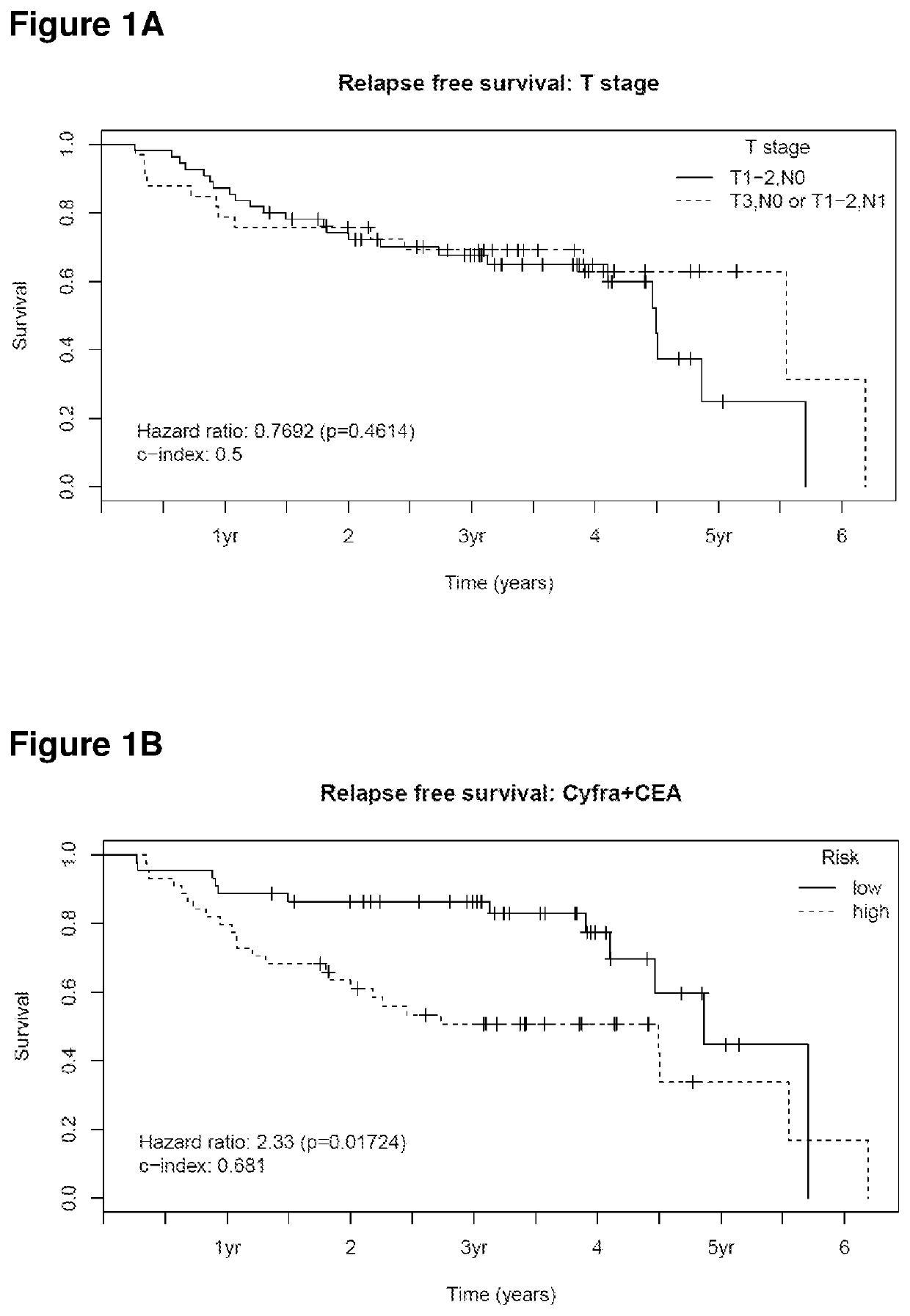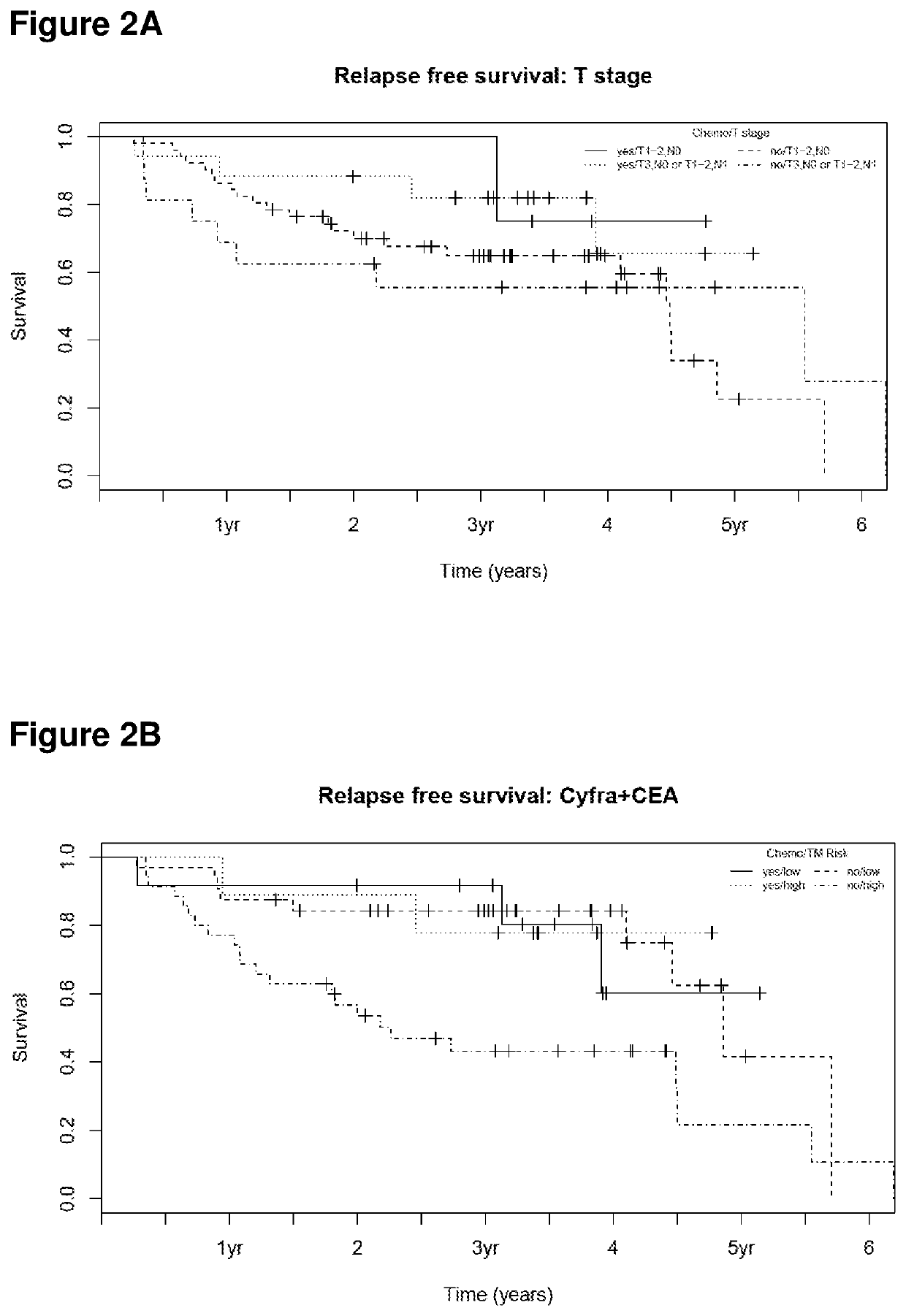Methods of identifying an individual to be treated by chemotherapy based on cytokeratin-19 fragments (CYFRA 21-1) and carcinoembryonic antigen (CEA) marker molecules and related uses
a technology of cytokeratin and individual treatment, applied in the field of identifying an individual to be treated by chemotherapy based on cytokeratin19, can solve the problems of no blood biomarker based standard of care, unsatisfactory clinical standard for patient selection for chemotherapy in scc-nsclc, and patients might be undertreated and others overtreated
- Summary
- Abstract
- Description
- Claims
- Application Information
AI Technical Summary
Benefits of technology
Problems solved by technology
Method used
Image
Examples
example 1
Definition of Weighting Factors and Cut-Off Value in a Reference Population
[0101]Example 1 describes how the weighting factors for the combination of Cyfra21-1 and CEA and the cut-off value on the combined value C are obtained in suitable reference population.
[0102]A suitable reference population should consist of patients with SCC-NSCLC for which baseline (before surgery) levels of Cyfra21-1 and CEA are known, a part of the patients should have received chemotherapy and a suitable outcome measurement (e.g. relapse free survival) should be available.
[0103]In a suitable cohort one may calculate a Cox's proportional hazards regression model with a suitable outcome measurement (e.g. relapse free survival) as a dependent variable and using Cyfra21-1 and CEA and optionally T-stage as independent variables.
[0104]The regression coefficients delivered by the Cox's proportional hazards regression model for Cyfra21-1, CEA and optionally T-stage can then be used as weighting factors in order t...
example 2
Determining Effectiveness of Chemotherapy in Various Subgroups of Patients with Stage I and II SCC-NSCLC
[0106]A population of 88 patients with stage I and II SCC-NSCLC was used in order to identify subgroups of patients, depending on their tumor stage and marker levels. It was the aim to clarify whether or not all subgroups should be treated by chemotherapy.
[0107]All patients underwent a resection of the tumor whereas 21 of these patients received chemotherapy in addition. The concentration of Cyfra21-1 and CEA were measured in serum samples which were collected before the resection.
[0108]The criterion which today is mostly used in clinical practice to select patients for chemotherapy is based on tumor size. To evaluate the suitability of stage to select patients for chemotherapy in the present cohort patients with stage T1-2,N0 were considered as low risk and patients with stage T3,N0 or T1-2,N1 were considered as high risk. Differences in relapse-free survival for patients with or...
example 3
Identifying a Patient as to be Treated by Chemotherapy
[0117]For a new patient one measures Cyfra21-1 and CEA from a suitable sample from this patient and calculates based on the defined weighting factors the combined value C of this patient. If for the patient the combined value C is above the previously defined cut-off one would select this patient for chemotherapy.
[0118]The weighting factors and the cut-off for the combined value C can be derived from any suitable cohort as described in Example 1 if one desires to independently establish such weighting factors and such cut-off value or one can use the weighting factors and the cut-off value as given in Example 2.
PUM
| Property | Measurement | Unit |
|---|---|---|
| body time | aaaaa | aaaaa |
| concentration | aaaaa | aaaaa |
| size | aaaaa | aaaaa |
Abstract
Description
Claims
Application Information
 Login to View More
Login to View More - R&D
- Intellectual Property
- Life Sciences
- Materials
- Tech Scout
- Unparalleled Data Quality
- Higher Quality Content
- 60% Fewer Hallucinations
Browse by: Latest US Patents, China's latest patents, Technical Efficacy Thesaurus, Application Domain, Technology Topic, Popular Technical Reports.
© 2025 PatSnap. All rights reserved.Legal|Privacy policy|Modern Slavery Act Transparency Statement|Sitemap|About US| Contact US: help@patsnap.com



